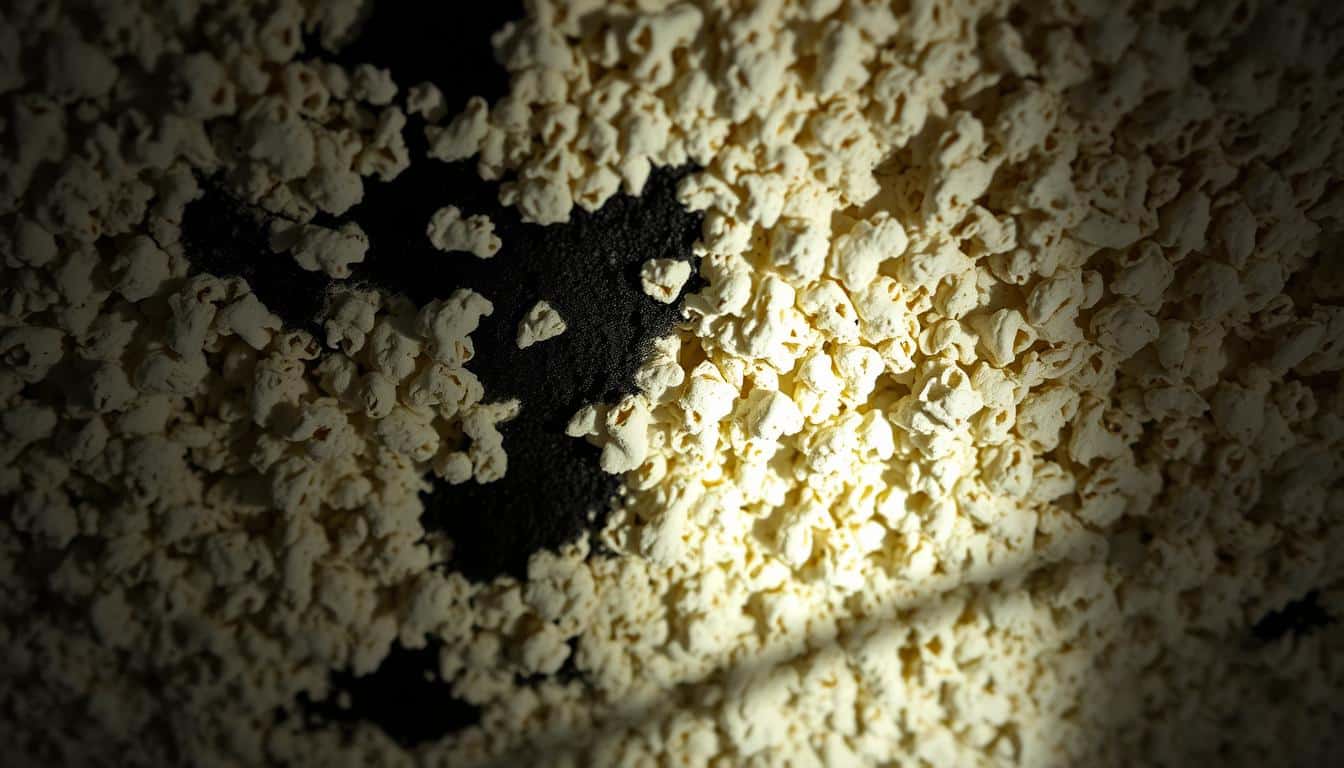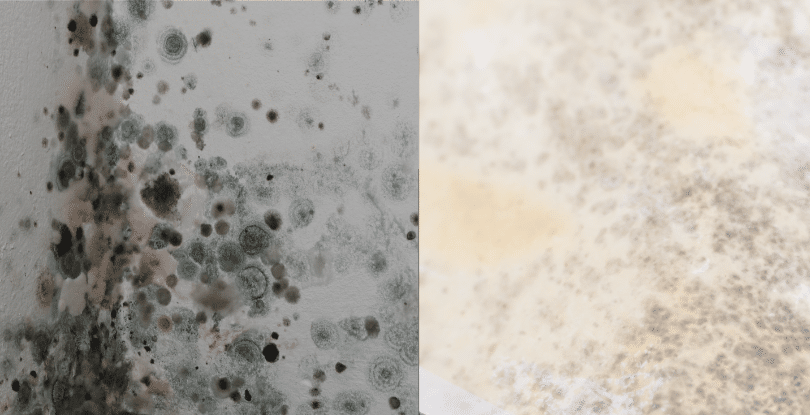Did you know popcorn ceilings were popular in homes from the 1950s to the 1960s? They can be a breeding ground for black mold. If your home was built before 1990, it might have asbestos in the ceiling. This material is harmful and can cause serious health issues.
This guide will show you how to remove black mold from your popcorn ceiling. It will help make your home safe and healthy.
Key Takeaways
- Popcorn ceilings can be prone to black mold growth, which can be a serious health concern.
- Homes built before 1990 may have popcorn ceilings containing asbestos, a carcinogenic material.
- Regular cleaning and maintenance are essential to prevent mold growth on popcorn ceilings.
- Proper safety precautions, including protective gear, are crucial when dealing with mold on popcorn ceilings.
- Effective mold removal solutions can be found using natural or chemical-based products.
Introduction to Popcorn Ceilings
Popcorn ceilings, also known as textured ceilings, were once popular in many American homes. They provided sound insulation and hid building flaws. Yet, they also had some downsides.
History and Popularity of Popcorn Ceilings
In the mid-20th century, popcorn ceilings became very popular. They were cheap and easy to put up. The unique look came from a mix of styrofoam and stucco sprayed on the ceiling.
This method was common in homes from the 1950s to the 1970s. It was a practical way to hide ceiling imperfections and add a unique look.
Advantages and Disadvantages of Popcorn Ceilings
- Advantages:
- They helped reduce noise by insulating sound
- They covered up ceiling flaws like cracks
- They had a distinctive, textured look that was in style back then
- Disadvantages:
While popcorn ceilings had their uses, their fragile nature and asbestos concerns have made them less popular today. Knowing about their history and issues is key for homeowners thinking about upkeep or removal.
Identifying Black Mold on Popcorn Ceilings
Popcorn ceilings were popular from 1930 to 1990. Unfortunately, they can become a home for black mold. This fungus, known as Stachybotrys chartarum or Stachybotrys atra, loves the textured surface of popcorn ceilings. It thrives in damp places like bathrooms and kitchens.
Signs of Black Mold Growth
Spotting black mold on your ceiling is key. Look for dark spots or fuzzy patches. These are clear signs of mold. Mold spores can spread easily, so it’s vital to act fast.
Health Risks Associated with Black Mold
Black mold is harmful because it makes mycotoxins, toxic substances. These can cause breathing problems, allergies, and weaken your immune system. Especially for those with health issues, inhaling mold spores is risky.
“Mold growth, especially black mold, is common on popcorn ceilings, especially in humid environments like bathrooms and kitchens.”
Popcorn ceilings might also have asbestos, which is dangerous. Trying to clean mold can spread spores and harm the ceiling. It’s best to hire experts for removal.
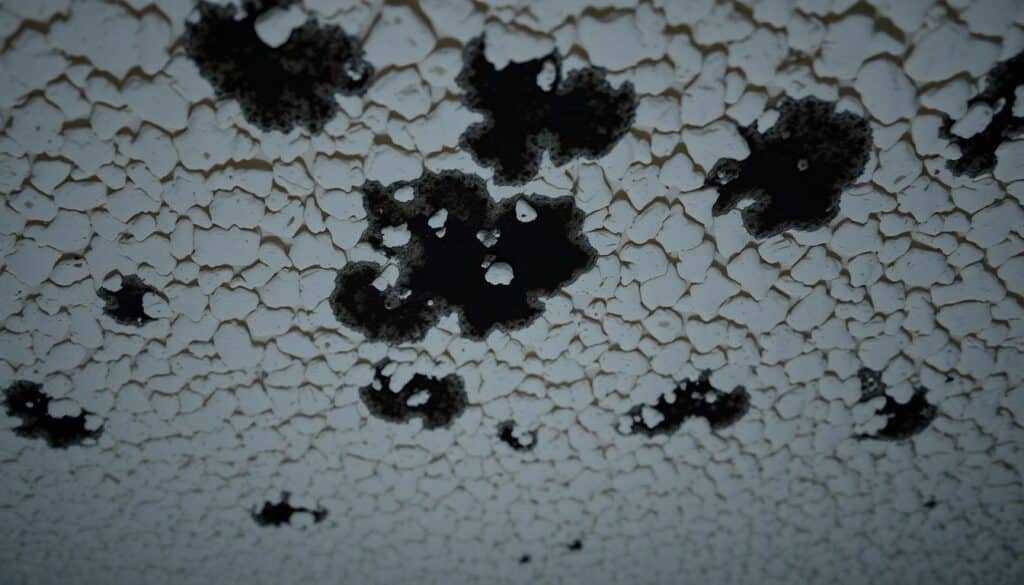
It’s important to tackle black mold on your ceiling to keep your home safe and healthy. Watch for mold signs and know the health risks. This way, you can act quickly to prevent bigger problems.
Preparing for Black Mold Removal
Before you start removing black mold from your popcorn ceiling, it’s important to be safe. Wear safety gear like a dust mask, safety goggles, gloves, and long sleeves. This helps prevent you from getting exposed to mold spores and debris.
Also, cover all furniture, floors, and other surfaces in the room with plastic sheets, tarps, or drop cloths. This protects them from the mess and mold spread during cleaning.
It’s crucial to prepare and contain the area properly. The United States Environmental Protection Agency (EPA) says you can handle small mold areas yourself. But for bigger ones, it’s best to get professional mold remediation services.
Safety Gear and Protective Equipment
- Dust mask or N95 respirator to prevent inhalation of mold spores
- Safety goggles to protect your eyes from debris and mold
- Work gloves to protect your hands from mold and cleaning solutions
- Long-sleeved clothing to cover your skin and prevent direct contact with mold
Covering Furniture and Floors
To stop mold and dust from spreading, cover all furniture, floors, and surfaces in the room. Use these materials to make a contained work area:
- Plastic sheeting or tarps to cover furniture and floors
- Drop cloths or old towels to protect any exposed surfaces
- Painter’s tape to secure the plastic sheeting or tarps in place
By following these safety precautions and containing the work area, you can safely remove black mold from your popcorn ceiling. This protects your home and health.
How to Get Rid of Black Mold on Popcorn Ceiling
Dealing with black mold on a popcorn ceiling can be tough. But, it’s key to act fast to keep your home healthy. Chicago knows how important it is to tackle mold problems quickly. This guide will show you how to remove black mold from your popcorn ceiling.
First, safety is a must when dealing with black mold. Wear goggles, a respirator, gloves, disposable clothes, and shoe covers. This keeps you safe and stops mold spores from spreading.
For mold removal, try eco-friendly options like oxygen bleach, white vinegar, hydrogen peroxide, and baking soda. These natural cleaners are good at killing mold without harsh chemicals.
- Begin by cleaning the surface to remove dirt or debris. Use a lint roller or microfiber duster to pick up mold spores.
- Then, apply your chosen mold remover to the moldy areas. Follow the instructions and let it sit before wiping it off.
- If mold stains still show, apply the cleaner again until the mold is gone.
- Finally, vacuum the area well to catch any leftover mold spores. Also, think about improving your bathroom’s ventilation to stop mold from coming back.
- Check for water leaks or moisture that might have caused the mold. Fix these issues to stop mold from coming back.
Remember, getting rid of black mold on a popcorn ceiling takes time and effort. By following these steps and using the right cleaners, you can solve the problem. This will help keep your home mold-free and healthy.
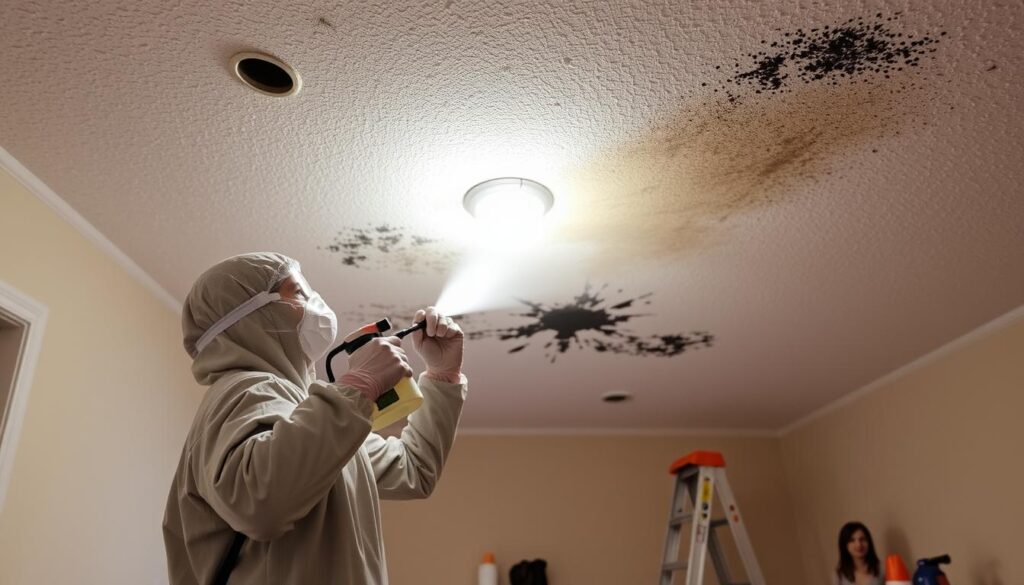
Step-by-Step Guide to Removing Black Mold
Removing black mold from popcorn ceilings can seem tough. But, with the right steps, you can get rid of it. Start by cleaning well and preparing the surface before using mold removal solutions.
Pre-Cleaning and Surface Preparation
First, dust the ceiling to remove loose debris. Use a microfiber cloth or a vacuum with a HEPA filter to catch mold spores. This stops them from spreading.
After cleaning, prepare the surface for mold removal. This step is crucial.
- Find and fix any moisture problems that cause mold. Fix leaks, ensure good air flow, and use a dehumidifier to control humidity.
- Lightly sand the area to expose the mold. This helps the solution work better.
- Wipe the ceiling with a damp cloth to remove dust. Don’t soak the popcorn texture, as too much water can harm it.
Applying Mold Removal Solutions
Now, apply the mold removal solution. You can use bleach-based cleaners or natural options like vinegar or hydrogen peroxide, depending on the mold’s severity.
- Mix the solution as directed by the manufacturer or your chosen recipe. Make sure to get the right ratio.
- Use a sprayer or microfiber mop to apply the solution. Be careful not to soak the popcorn texture.
- Let the solution work for about 10 minutes. This allows it to penetrate and remove mold effectively.
- Blot the area with a clean, damp cloth to remove any leftover mold and solution.
By following this guide, you can remove black mold from your popcorn ceiling. This will make your home clean and healthy again.
Mold Removal Solutions for Popcorn Ceilings
When you find black mold on your popcorn ceiling, picking the right solution is key. You can choose from natural, eco-friendly options or chemical-based removers. Each method has its own way to get rid of mold and stop it from coming back.
Natural and Eco-Friendly Options
For a gentle and green approach, natural mold removers are a great choice. You can use white vinegar, hydrogen peroxide, or baking soda. These natural mold removers are safe for you and the planet.
Chemical-Based Mold Removers
For serious or widespread popcorn ceiling mold treatment, chemical-based mold removers might be needed. These mold removal solutions can reach deep into the popcorn ceiling to kill mold. But, always test them first on a small area to make sure they won’t harm your ceiling.
It’s also vital to fix the moisture problem that’s causing the mold. Good ventilation, controlling humidity, and fixing leaks or water damage are key. This way, you can keep your popcorn ceiling mold-free without using harsh chemicals.
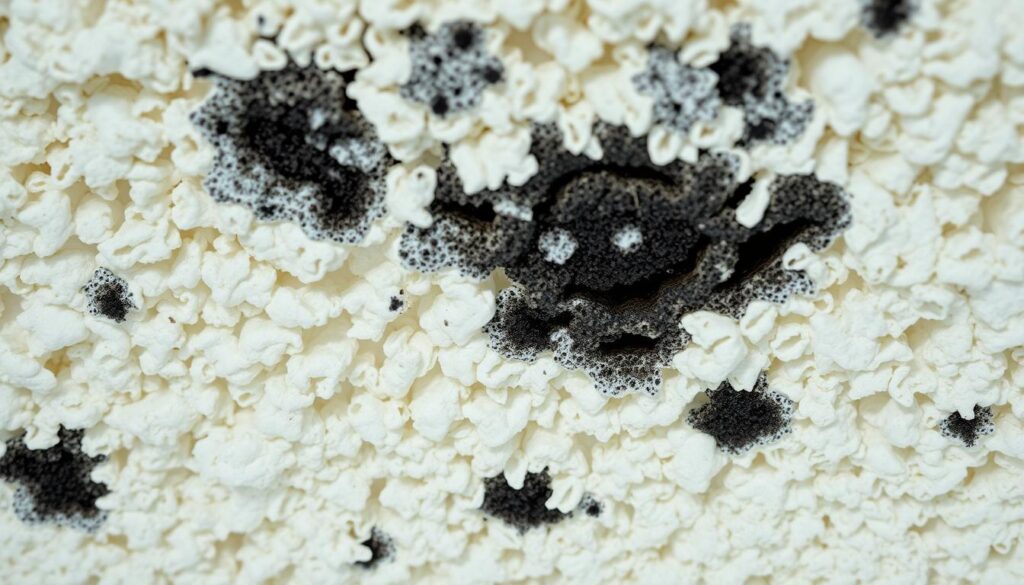
| Mold Removal Solution | Effectiveness | Safety Considerations |
|---|---|---|
| White Vinegar | Highly effective in killing mold | Natural, safe for homeowners and the environment |
| Hydrogen Peroxide | Effective in killing and removing mold | Natural, mild oxidizing agent |
| Baking Soda | Effective in absorbing and removing mold | Natural, non-toxic |
| Chemical-Based Mold Removers | Highly effective in eliminating severe mold growth | Require proper handling and ventilation |
“When dealing with mold, it’s crucial to address the root cause – moisture – to prevent future outbreaks. A combination of the right cleaning solutions and resolving the underlying moisture issues is key to maintaining a healthy, mold-free popcorn ceiling.”
Safely Disposing of Moldy Materials
Getting rid of mold-contaminated waste is key after removing black mold from your ceiling. It’s important to handle and throw away any contaminated stuff carefully.
First, seal cleaning rags, sponges, and protective gear in plastic bags. Then, throw them in an outdoor trash can or dumpster. This stops mold spores from spreading and keeps everyone safe.
If you had to remove parts of the ceiling because of mold, you need to get rid of them right. You must follow local rules for throwing away hazardous waste. You might need to call a professional waste service to make sure you’re doing it right.
| Mold Removal Location | Average Cost Range |
|---|---|
| Air Ducts | $600 to $2,000 |
| Attic | $1,000 to $4,000 |
| Basement | $500 to $3,000 |
| Bathroom | $500 to $1,000 |
| Crawl Space | $500 to $2,000 |
| Drywall | $1,000 to $20,000 |
| HVAC | $3,000 to $10,000 |
| Whole House | $10,000 to $30,000 |
The cost to dispose of mold safely can change based on how much mold there is and local rules. By following the right steps, you can make sure your home is safe and healthy for everyone.
Preventing Future Black Mold Growth
To keep black mold away from your popcorn ceiling, you must tackle the root causes. Look for and fix any moisture or humidity problems in your bathroom or nearby. Good ventilation and air flow are key to stopping excess moisture that can cause mold.
Addressing Moisture and Humidity Issues
Winter’s cooler air makes moisture linger, leading to more mold on bathroom ceilings. Mold can harm your breathing, making it vital to remove it quickly. Regularly clean and check your popcorn ceiling. Fix any water damage or leaks fast to keep mold away.
Proper Ventilation and Air Circulation
Good ventilation and air flow stop mold by preventing moisture buildup. Use an exhaust fan and dry the floor often to prevent mold. Also, open doors and windows for better air circulation to keep your space mold-free.
By taking these steps, homeowners can lower the chance of black mold coming back. This helps keep your living space safe and healthy.
“Mold and mildew can grow on a wide range of household surfaces and develop within 24 to 48 hours on a damp surface.”
When to Hire Professional Mold Remediation Services
Removing black mold on a popcorn ceiling can be done by homeowners. But, there are times when you should call in the pros. If the mold area is big, the mold is severe, or you think it might be asbestos, get a certified mold removal expert.
These experts have the right tools, training, and know-how. They can safely remove the mold and follow local rules. They also keep everyone’s health safe. Sometimes, they need to do mold inspection and mold testing to figure out the best way to fix it.
The guide says about 30% of the time, you’ll need a mold removal pro. It also advises getting quotes from different contractors. Prices can vary a lot in the mold remediation industry.
For a fair view of what needs to be done, use different contractors for the plan and the cleanup. It’s also smart to check references and insurance of the contractor. This makes sure they’re trustworthy and reliable.
| Mold Remediation Considerations | Importance |
|---|---|
| Extensive mold growth | Requires professional mold remediation services |
| Presence of asbestos | Necessitates certified mold removal experts |
| Compliance with local regulations | Ensured by professional mold remediation contractors |
| Protecting occupant health | Prioritized by certified mold removal professionals |
By choosing professional mold remediation services, you ensure the mold is safely removed. They also fix any moisture problems and stop mold from coming back. This keeps your family safe and healthy.
Maintaining a Mold-Free Popcorn Ceiling
Keeping your popcorn ceiling mold-free is vital for a healthy home. After removing black mold, a regular cleaning and inspection routine is crucial. This way, you can prevent mold from coming back and keep your ceiling looking great.
Regular Cleaning and Inspection
Dusting and cleaning your popcorn ceiling regularly is key. Dirt, debris, and moisture can build up, creating a mold-friendly environment. Wipe the ceiling gently with a microfiber cloth each month to keep it clean and mold-free.
Also, inspect the ceiling for mold or water damage signs. Early detection helps you fix the problem before it gets worse. This saves you time, money, and health risks.
Addressing Leaks and Water Damage Promptly
Moisture, often from leaks or water damage, is a major mold cause. Fixing leaks or water issues quickly stops mold growth. This way, you remove the moisture source and lower mold risk.
Regular inspections and watching for moisture can prevent mold. This ensures your popcorn ceiling stays beautiful and healthy. By being proactive, you can keep your ceiling mold-free and enjoy a clean home.
Conclusion
Dealing with black mold on a popcorn ceiling is crucial for a healthy home. This guide shows how to remove black mold and keep ceilings mold-free. Always put safety first when removing mold, and get help if needed.
By tackling mold and keeping up with maintenance, I can have a clean ceiling. It’s important to spot mold early, use the right solutions, and prevent it from coming back. A mold-free ceiling means a healthier home for me and my family.
FAQ
What are the signs of black mold growth on a popcorn ceiling?
Signs include discoloration, dark spots, or fuzzy-looking patches on the ceiling.
What are the health risks associated with black mold exposure?
Exposure can cause respiratory problems, allergic reactions, and weaken the immune system. This is especially true for those with pre-existing health conditions.
What safety precautions should be taken when removing black mold from a popcorn ceiling?
Wear personal protective equipment like a dust mask, safety goggles, work gloves, and long sleeves. Also, cover furniture, floors, and surfaces with plastic sheets, tarps, or drop cloths.
What are the different mold removal solutions that can be used on a popcorn ceiling?
Solutions include natural options like white vinegar, hydrogen peroxide, and baking soda. Chemical-based mold removers are also available for severe cases.
How can future black mold growth on a popcorn ceiling be prevented?
Prevent future growth by addressing moisture and humidity, ensuring ventilation, and regular cleaning. Also, fix any water damage or leaks promptly.
When is it necessary to hire professional mold remediation services for a popcorn ceiling?
Hire professionals if the mold area is large, the growth is severe, or if you suspect asbestos. They have the right tools and knowledge to handle the problem safely.


